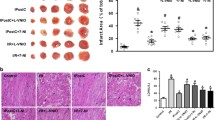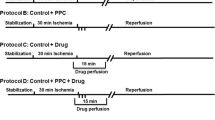Abstract
The effect of ischemic preconditioning and superoxide dismutase (SOD) on endothelial glycocalyx and endothelium-dependent vasodilation in the postischemic isolated guinea-pig hearts was examined. Seven groups of hearts were used: group 1 underwent sham aerobic perfusion; group 2 was subjected to 40 min global ischemia without reperfusion; group 3, 40 min ischemia followed by 40 min reperfusion; group 4 was preconditioned with three cycles of 5 min global ischemia followed by 5 min of reperfusion (IPC), prior to 40 min ischemia; group 5 was subjected to IPC prior to standard ischemia/reperfusion; group 6 underwent standard ischemia/reperfusion and SOD infusion (150 U/ml) was begun 5 min before 40 min ischemia and continued during the initial 5 min of the reperfusion period; group 7 was subjected to 80 min aerobic perfusion with NO-synthase inhibitor, L-NAME, to produce a model of endothelial dysfunction independent from the ischemia/reperfusion. Coronary flow responses to acetylcholine (ACh) and sodium nitroprusside (SNP) were used as measures of endothelium-dependent and endothelium-independent vascular function, respectively. Reduction in coronary flow caused by NO-synthase inhibitor, L-NAME, served as a measure of a basal endothelium-dependent vasodilator tone. After completion of each experimental protocol, the hearts were stained with ruthenium red or lanthanum chloride for electron microscopy evaluation of the endothelial glycocalyx. While ischemia led only to a slightly flocculent appearance of the glycocalyx, in ischemia/reperfused hearts the glycocalyx was disrupted, suggesting that it is the reperfusion injury which leads to the glycocalyx injury. Moreover, the coronary flow responses to ACh and L-NAME were impaired, while the responses to SNP were unchanged in the ischemia/reperfused hearts. The disruption of the glycocalyx and the deterioration of ACh and L-NAME responses was prevented by IPC. In addition, the alterations in the glycocalyx and the impairment of ACh responses were prevented by SOD. The glycocalyx appeared to be not changed in the hearts subjected to 80 min aerobic perfusion with L-NAME. In conclusion: (1) the impairment of the endothelium-dependent coronary vasodilation is paralleled by the endothelial glycocalyx disruption in the postischemic guinea-pig hearts; (2) both these changes are prevented by SOD, suggesting the role of free radicals in the mechanism of their development; (3) both changes are prevented by IPC. We hypothesize, therefore, that alterations in the glycocalyx contribute to the mechanism of the endothelial dysfunction in the postischemic hearts.
Similar content being viewed by others
References
VanBenthuysen KM, Mcmurtry IF, Horwitz LD: Reperfusion after coronary occlusion in dogs impairs endothelium-dependent relaxation to acetylcholine and augments contractile reactivity in vitro. J Clin Invest 79: 265–274, 1987
Mehta JL, Nichols WW, Donnelly WH, Lawson DL, Saldeen TGP: Impaired canine coronary vasodilator response to acetylcholine and bradykinin after occlusion-reperfusion. Circ Res 64: 43–54, 1989
Pearson PJ, Schaff HV, Vanhoutte PM: Long-term impairment of endothelium dependent relaxations to aggregating platelets after reperfusion injury in canine coronary arteries. Circulation 81: 1921–1927, 1990
Tsao PS, Aoki N, Lefer DJ, Johnson G III, Lefer AM: Time-course of endothelial dysfunction and myocardial injury during ischemia and reperfusion in the cat. Circulation 82: 1402–1412, 1990
Defily DV, Chilian WM: Preconditioning protects coronary arteriolar endothelium from ischemia-reperfusion injury. Am J Physiol 265: H700–H706, 1993
Ma X-L, Weyrich AS, Lefer DJ, Lefer AM: Diminished basal nitric oxide release after myocardial ischemia and reperfusion promotes neutrophil adherence to coronary endothelium. Circ Res 72: 403–412, 1993
Horwitz LD, Kaufman D, Keller MW, Kong YO: Time course of coronary endothelial healing after injury due to ischemia and reperfusion. Circulation 90: 2439–2447, 1994
Richard V, Kaeffer N, Tron C, Thuillez C: Ischemic preconditioning protects against coronary endothelial dysfunction induced by ischemia and reperfusion. Circulation 89: 1254–1261, 1994
Ehring T, Krajcar M, Baumgart D, Kompa S, Hummelgen M, Heusch G: Cholinergic and alpha-adrenergic coronary constriction with increasing ischemia-reperfusion injury. Am J Physiol 37: H886–H894, 1995
Sobey CG, Woodman OL: Myocardial ischaemia-what happens to the coronary arteries? Trends Pharmacol Sci 14: 448–453, 1993
Lefer AM, Lefer DJ: The role of nitric oxide and cell adhesion molecules on the microcirculation in ischaemia-reperfusion. Cardiovasc Res 32: 743–751, 1996
Mehta JL, Nichols WW, Donnelly WH, Lawson DL, Thompson L, ter Riet M, Saldeen TGP: Protection by superoxide dismutase from myocardial dysfunction and attenuation of vasodilator reserve after coronary occlusion and reperfusion in dog. Circ Res 65: 1283–1295, 1989
Dauber IM, Lesnefsky EJ, VanBenthuysen KM, Weil JV, Horwitz LD: Reactive oxygen metabolite scavengers decrease functional coronary microvascular injury due to ischemia-reperfusion. Am J Physiol 260: H42–H49, 1991
Gross GJ, Orourke ST, Pelc LR, Warltier DC: Myocardial and endothelial dysfunction after multiple, brief coronary occlusions-role of oxygen radicals. Am J Physiol 263: H1703–H1709, 1992
Murry CE, Jennings RB, Reimer KA: Preconditioning with ischemia: A delay of lethal cell injury in ischemic myocardium. Circulation 74: 1124–1136, 1986
Lawson CS, Downey JM: Preconditioning-state of the art myocardial protection. Cardiovasc Res 27: 542–550, 1993
Parratt JR: Protection of the heart by ischaemic preconditioning-mechanisms and possibilities for pharmacological exploitation. Trends Pharmacol Sci 15: 19–25, 1994
Kaeffer N, Richard V, Francois A, Lallemand F, Henry JP, Thuillez C: Preconditioning prevents chronic reperfusion-induced coronary endothelial dysfunction in rats. Am J Physiol 40: H842–H849, 1996
Kolocassides KG, Galinanes M, Hearse DJ: Ischemic preconditioning, cardioplegia or both? differing approaches to myocardial and vascular protection. J Mol Cell Cardiol 28: 623–634, 1996
Loke KE, Woodman OL: Effect of ischaemic preconditioning on vascular dysfunction induced by ischaemia and reperfusion in rat hindquarters. Cardiovasc Res 32: 1081–1087, 1996
Ishiharajima S, Aida T, Nakagawa R, Kameyama K, Sugano K, Oguro T, Asano G: Early membrane damage during ischemia in rat heart. Exp Mol Pathol 44: 1–6, 1986
Haack DW, Bush LR, Schlafer M, Lucchesi BR: Lanthanum staining of coronary microvascular endothelium. Effects of ischemia reperfusion, propranolol and atenolol. Microvasc Res 21: 362–376, 1981
Ward BJ, Donnelly JL: Hypoxia induced disruption of the cardiac endothelial glycocalyx: Implications for capillary permeability. Cardiovasc Res 27: 384–389, 1993
Czarnowska E, Karwatowska-Prokopczuk E: Ultrastructural demonstration of endothelial glycocalyx disruption in the reperfused rat heart. Involvement of oxygen free radicals. Basic Res Cardiol 90: 357–364, 1995
Richard V, Blanc T, Kaeffer N, Tron C, Thuillez C: Myocardial and coronary endothelial protective effects of acetylcholine after myocardial ischaemia and reperfusion in rats: role of nitric oxide. Br J Pharmacol 115: 1532–1538, 1995
Bilińska M, Mączewski M, Beręsewicz A: Donors of nitric oxide mimic effects of ischaemic preconditioning of reperfusion induced arrhythmias in isolated rat heart. Mol Cell Biochem 160/161: 265–271, 1996
Karwatowska-Prokopczuk E, Czarnowska E, Beręsewicz A: Iron availability and free radical induced injury in isolated ischemic/reperfused rat heart. Cardiovasc Res 26: 1–9, 1992
Miki S, Ashraf M, Salka S, Sperelakis N: Myocardial dysfunction and ultrastructural alterations mediated by oxygen metabolites. J Mol Cell Cardiol 20: 1009–1024, 1988
Miyamae M, Diamond I, Weiner MW, Camacho SA, Figueredo VM: Regular alcohol consumption mimics cardiac preconditioning by protecting against ischemia-reperfusion injury. Proc Natl Acad Sci USA 94: 3235–3239, 1997
Urabe K, Miura T, Iwamoto T, Ogawa T, Goto M, Sakamoto J, Iimura O: Preconditioning enhances myocardial resistance to postischaemic myocardial stunning via adenosine receptor activation. Cardiovasc Res 27: 657–662, 1993
Steenbergen C, Perlman ME, London RE, Murphy E: Mechanism of preconditioning. Ionic alterations. Circ Res 72: 112–125, 1993
Miyamae M, Fujiwara H, Kida M, Yokota R, Tanaka M, Katsuragawa M, Hasegawa K, Ohura M, Koga K, Yabuuchi Y, Sasayama S: Preconditioning improves energy metabolism during reperfusion but does not attenuate myocardial stunning in porcine hearts. Circulation 88: 223–234, 1993
Ovize M, Przyklenk K, Hale SL, Kloner RA: Preconditioning does not attenuate myocardial stunning. Circulation 85: 2247–2254, 1992
Tosaki A, Cordis GA, Szerdahelyi P, Engelman RM, Das DK: Effects of preconditioning on reperfusion arrhythmias, myocardial functions, formation of free radicals, and ion shifts in isolated ischemic/reperfused rat hearts. J Cardiovasc Pharmacol 23: 365–373, 1994
Park JW, Chun YS, Kim YH, Kim CH, Kim MS: Ischemic preconditioning reduces O2–generation and prevents respiratory impairment in the mitochondria of post-ischemic reperfused heart of rat. Life Sci 60: 2207–2219, 1997
Hoshida S, Kuzuya T, Fuji H, Yamashita N, Oe H, Hori M, Suzuki K, Taniguchi N, Tada M: Sublethal ischemia alters myocardial antioxidant activity in canine heart. Am J Physiol 264: H33–H39, 1993
Turrens JF, Thornton J, Barnard ML, Snyder S, Liu G, Downey JM: Protection from reperfusion injury by preconditioning hearts does not involve increased antioxidant defenses. Am J Physiol 262: H585–H589, 1992
Fu LX, Kirkeboen KA, Liang QM, Sjogren KG, Hjalmarson A, Ilebekk A: Free radical scavenging enzymes and g-protein mediated receptor signalling systems in ischaemically preconditioned porcine myocardium. Cardiovasc Res 27: 612–616, 1993
Suarez J, Rubio R: Regulation of glycolytic flux by coronary flow in guinea pig heart. Role of vascular cell glycocalyx. Am J Physiol 261: H1994–H2000, 1991
Kim YD, Fomsgaard JS, Heim KF, Ramwell PW, Thomas G, Kagan E, Moore SP, Coughlin SS, Kuwahara M, Analouei A, Meyers AK: Brief ischemia-reperfusion induces stunning of endothelium in canine coronary artery. Circulation 85: 1473–1482, 1992
Flavahan NA: Atherosclerosis or lipoprotein-induced endothelial dysfunction. Potential mechanisms underlying reduction in EDRF/nitric oxide activity. Circulation 85: 1927–1938, 1992
Author information
Authors and Affiliations
Rights and permissions
About this article
Cite this article
Beręsewicz, A., Czarnowska, E. & Mączewski, M. Ischemic preconditioning and superoxide dismutase protect against endothelial dysfunction and endothelium glycocalyx disruption in the postischemic guinea-pig hearts. Mol Cell Biochem 186, 87–97 (1998). https://doi.org/10.1023/A:1006867214448
Issue Date:
DOI: https://doi.org/10.1023/A:1006867214448




